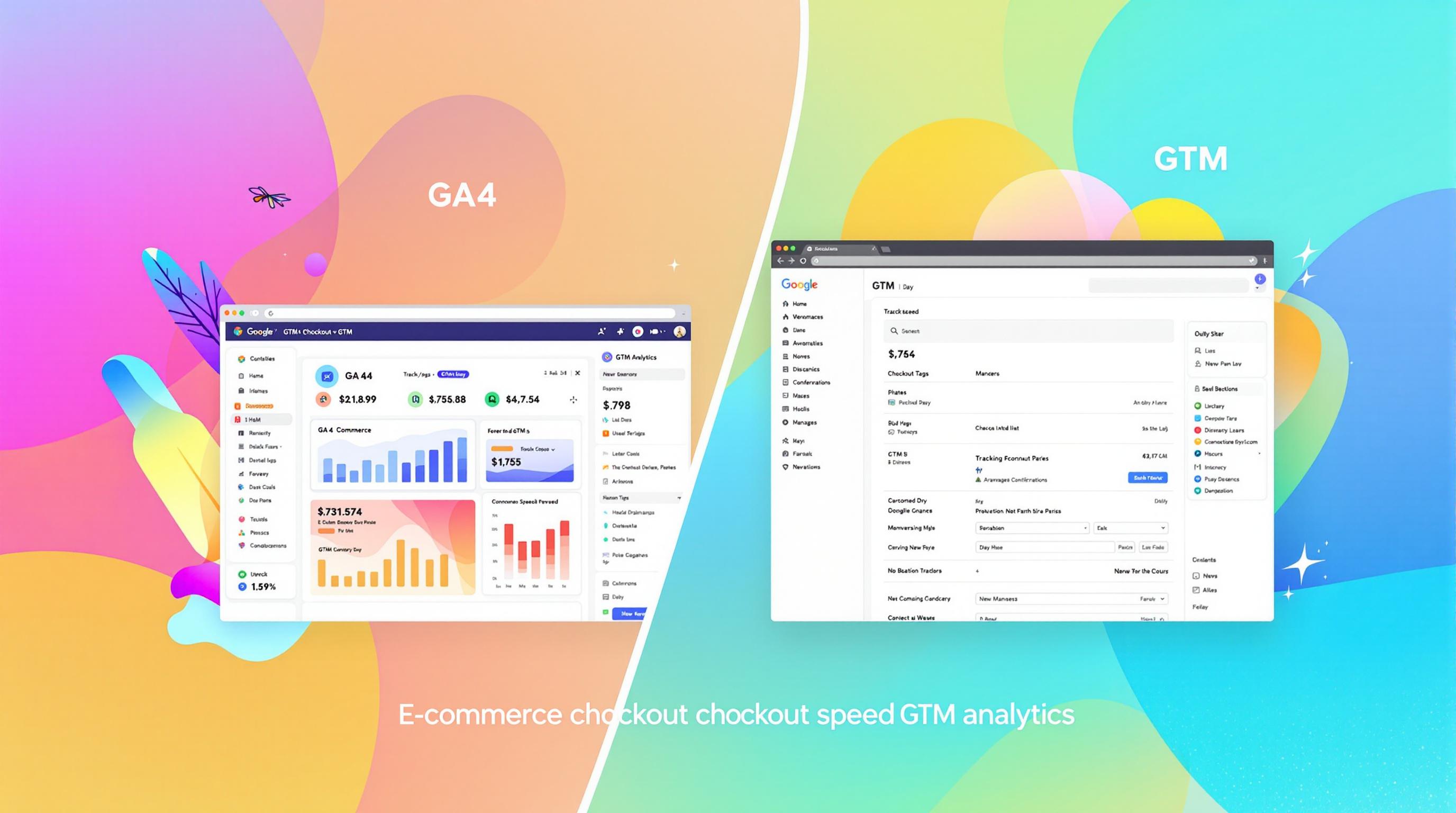Want to track your ecommerce data accurately in GA4? It all starts with setting up a structured data layer. Here's what you need to know:
- What is a Data Layer? It's the bridge that connects your website with GA4, capturing key events like product views, cart additions, and purchases.
- Key Challenges: Setting up a data layer can be tricky due to technical complexity, incorrect event tracking, and integration issues.
- What You’ll Learn:
- How to structure your data layer for accurate tracking
- Using Google Tag Manager (GTM) to configure and test ecommerce events
- Ensuring data accuracy and compliance with privacy laws
Quick Tip: A well-structured data layer and server-side tagging can significantly improve tracking accuracy and privacy compliance.
Let’s dive into the step-by-step process to set up your GA4 ecommerce tracking seamlessly.
Data Layer in Google Tag Manager: GTM Data Layer Tutorial

Components of a Reliable GA4 Data Layer

Getting your GA4 data layer right is crucial for managing technical challenges and ensuring data accuracy. A well-structured data layer aligns perfectly with GA4's requirements, making it easier to track and analyze ecommerce interactions.
Types of GA4 Ecommerce Events and Variables
GA4 uses specific ecommerce events to monitor key customer actions during their purchase journey. Each event requires certain variables to collect accurate data:
| Event Name | Purpose | Required Variables | Optional Variables |
|---|---|---|---|
| view_item | Tracks product page views | item_id, item_name | price, currency, item_category |
| add_to_cart | Monitors cart additions | items[], value | currency, coupon_code |
| begin_checkout | Tracks checkout initiation | items[] | coupon_code, payment_type |
| purchase | Records completed purchases | transaction_id, items[], revenue | tax, shipping, promotion_id |
Structuring the Data Layer for Ecommerce
Here's an example of how a data layer for a view_item event should look:
{
"event_name": "view_item",
"ecommerce": {
"items": [{
"item_id": "SKU_12345",
"item_name": "Classic Cotton T-Shirt",
"price": 25.00,
"quantity": 1
}]
}
}
The ecommerce.items array is key to supplying GA4 with product-specific details [2]. Once this structure is in place, focus on identifying the variables needed for precise data collection.
Implementation Guidelines
When setting up your data layer, keep these points in mind:
-
Product Data
Include variables likeitem_idanditem_namefor identifying products. Numeric values such aspriceandquantityshould be formatted correctly. Add details like category or variant if needed. -
Transaction Data
Usetransaction_idto track purchases. Add values forrevenue,tax, andshipping. If applicable, include payment methods and promotion details.
Proper formatting of numeric values (e.g., price, quantity) is critical to prevent errors during data processing [2].
sbb-itb-38e9f15
Setting Up GA4 Ecommerce Tracking with Google Tag Manager
Creating a GA4 Property and GTM Framework
To track ecommerce activity in GA4, you'll need a GA4 property with its Measurement ID and a GTM container. Start by creating a GA4 configuration tag in GTM using the Measurement ID. This tag serves as the backbone for tracking all ecommerce events.
This setup ensures your website, GTM, and GA4 work together without any hiccups.
| Setup Component | Required Elements | Purpose |
|---|---|---|
| GA4 Property | Measurement ID | Links to your analytics property |
| GTM Container | Configuration Tag | Base for tracking ecommerce events |
| Data Layer | ecommerce Object | Holds transaction data |
Configuring Ecommerce Event Tags in GTM
In GTM, you’ll need to create specific tags for each ecommerce event:
-
Event-Specific Tags
Use the following setup for an "add_to_cart" event:
Tag Type: Google Analytics 4 Event Event Name: add_to_cart Parameters: items ({{DL - ecommerce.items}}), value ({{DL - ecommerce.value}}), currency ({{DL - ecommerce.currency}}) - Custom Triggers Set up triggers that detect specific data layer events based on your structure.
-
Data Layer Variables
Map ecommerce data by defining variables in GTM. For example:
Variable Name: DL - ecommerce.items Variable Type: Data Layer Variable Data Layer Variable Name: ecommerce.items
Once your tags, triggers, and variables are ready, you’ll need to test them thoroughly.
Testing and Debugging Ecommerce Tags in GTM
Use GTM’s Preview Mode to check if event triggers work as expected during the purchase process. Then, verify the data in GA4’s DebugView to ensure everything is being transmitted correctly.
Here’s a checklist to guide your testing:
| Test Point | Verification Method | Expected Outcome |
|---|---|---|
| Event Firing | GTM Preview Mode | Events trigger as intended |
| Data Accuracy | GA4 DebugView | Data matches the event |
| Error Handling | Browser Console | No JavaScript errors |
Testing is crucial to ensure your setup is reliable and error-free.
Ensuring Data Accuracy and Compliance in GA4
Keeping Data Accurate and Consistent
Regularly reviewing and monitoring your data setup is key to catching and fixing collection problems. Weekly audits of your data layer, daily checks on transaction details, and real-time monitoring for errors help maintain reliable and consistent data.
| Audit Component | Frequency | Key Checks |
|---|---|---|
| Data Layer Structure | Weekly | Event syntax, required parameters, value formatting |
| Event Validation | Daily | Transaction IDs, revenue values, currency codes |
| Error Monitoring | Real-time | JavaScript errors, missing parameters, failed triggers |
Set up custom alerts in GA4 to flag unusual changes, like sudden spikes or drops in purchase events. These can signal potential tracking issues. Alongside accuracy, staying compliant with privacy laws is just as important for a solid GA4 setup.
Staying Compliant with Privacy Laws
Using a Consent Management Platform (CMP) helps align your practices with regulations like GDPR and CCPA. Adjust data retention settings, enforce user consent, and handle deletion requests to stay on the right side of privacy laws.
"A well-structured data layer is the foundation of accurate GA4 ecommerce tracking." - Himanshu Sharma, Founder of Optimize Smart [1]
In addition to protecting user data, server-side tagging can enhance both tracking accuracy and privacy in ecommerce.
Leveraging Server-Side Tagging for Better Accuracy
Server-side tagging is a smart way to tackle challenges with accuracy and compliance. By processing data on your servers before sending it to GA4, you gain more control over data quality and reduce client-side issues.
This method improves accuracy by minimizing data loss, collecting data directly on your server for better privacy, and ensuring uniform data formats. It also works around ad blockers and helps meet privacy regulations.
"Server-side tagging is a game-changer for first-party data collection and privacy compliance." - Simo Ahava, Analytics Consultant [2]
For ecommerce setups with complex tracking needs, server-side tagging ensures dependable data by:
- Validating and processing ecommerce events before sending them
- Standardizing data formats across platforms
- Reducing data loss caused by ad blockers
- Giving you better control over sensitive customer data
Pro Tip: When setting up server-side tagging, stick closely to GA4's ecommerce schema while taking full advantage of server-side features.
Conclusion and Expert Support for GA4 Implementation
GA4 Data Layer Setup: Key Points
Setting up a GA4 data layer requires careful planning, accurate event tracking, and ongoing monitoring to ensure meaningful insights. Here’s a quick look at the core elements that contribute to a solid implementation:
| Component | Benefit | Focus Area |
|---|---|---|
| Data Layer Structure | Consistent event tracking | Standardized variable naming and formatting |
| Server-Side Tagging | Better data accuracy | First-party data collection and privacy rules |
| GTM Configuration | Reliable event handling | Proper event validation and debugging |
Although the process can be challenging, having the right expertise can simplify it and ensure everything runs smoothly.
How Web Star Research Can Help

Web Star Research specializes in making GA4 setups easier and more effective. They tackle common challenges with solutions like:
- Technical Implementation: Customizing data layers and tracking ecommerce events to match your business needs.
- Data Accuracy: Using advanced server-side tagging to ensure reliable first-party data collection.
- Privacy Compliance: Integrating Consent Management Platforms to meet GDPR and CCPA requirements.
Their services are designed to address the technical hurdles and data accuracy concerns mentioned earlier, helping businesses lay a strong foundation for analytics.
"Server-side tagging implementation has become crucial for businesses serious about first-party data collection and privacy compliance in their analytics setup." - Ali Shah, Web Star Research [3]
A successful GA4 ecommerce setup goes beyond just technical execution. It’s about building a dependable analytics system that provides accurate insights while honoring privacy and data protection standards.



